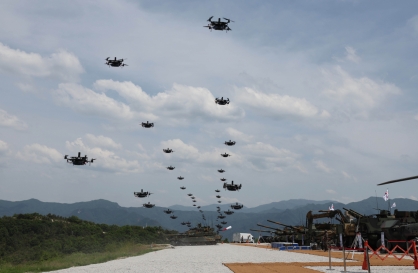
I spent much of my professional life deployed forward in the Arabian Gulf and encountered Iranian naval forces there on many occasions. They were uniformly unprofessional, confrontational, and clearly seized with making life as difficult as possible for both legitimate merchant shipping and naval warships from the many nations with whom the Iranians have intractable differences. They are cowardly in the face of opposing military forces, but dangerous and unpredictable.
As I watch the situation in Gaza escalate, I fear the chances of Iran intervening by unleashing the 130,000 missiles Hezbollah has been storing to the north of Israel rising. Immediately after Hamas’ shameful and devastating attack on Israel on Oct. 7, I would have assessed the chances of a direct or proxy intervention by Iran at around 10 percent. But as world opinion begins to turn against Israel in the wake of inevitable civilian casualties in Gaza, Iran is becoming more emboldened.
They are conducting probing attacks from the north, trying to assess if the Israelis have kept a strategic reserve sufficient to deal with a second front emanating from Lebanon. They have also conducted around 20 proxy attacks against US forces in Iraq and Syria, likewise, seeking to determine what the US response might look like. Iran-backed Houthi rebels recently launched missiles from the southern Arabian peninsula -- which were shot down by an American destroyer. They have engaged in cyberattacks targeting Israel and others in the region. Clearly Iran is testing the waters to see if an escalation would be effective.
I’ve seen this sequence before in the Arabian Gulf. When I was a department head on an Aegis cruiser in the late 1980s, I watched them harass legitimate tanker traffic, anonymously dump mines into the critical choke point of the Strait of Hormuz and try to overfly and target US warships like mine.
Ultimately, we were forced to destroy a significant chunk of the Iranian Navy in Operation Praying Mantis in April 1988. The Navy sank an Iranian frigate and crippled another. They also sank a gunboat, three speedboats and destroyed a number of platforms in the Gulf from which the Revolutionary Guard forces were operating.
Iran is increasingly likely to push Israel and the US, and I’d say the chances of a serious attack by Iran have risen uncomfortably high, to over 20 percent. It could close the Strait of Hormuz, spike oil prices, and move forward in unpredictable ways, especially with two US carrier strike groups, multiple Air Force attack aircraft squadrons, and an expeditionary Marine strike group on station today. Direct combat between US and Iranian forces is not out of the question.
What further options are available to President Joe Biden if Iran miscalculates his blunt warning to the ayatollahs -- which was a simple “Don’t?”
If Iran decides to lash out either through more proxy activity -- notably from Hezbollah -- or even directly, Biden will be receiving a detailed list of options to take in response. I’ve been part of preparing such lists over the years, and it is a daunting thing to do, knowing that you are developing, in effect, a menu of death and destruction.
Certainly, the Pentagon already has detailed target lists of Iranian facilities based on years of confrontation going back to the Iranian hostage crisis of 1979. Some of the options likely to be considered include :
•Cyberattacks conducted by US Cyber Command with backup from the National Security Agency, targeting critical Iranian infrastructure: oil and gas facilities, refineries, shipping terminals, and possibly the electric grid of both Lebanon and Iran. All would be legitimate military targets if struck in response to Iranian adventurism in the current crisis.
•Special forces operations against Hezbollah, which might include joint missions with Israeli counterparts, designed to undermine command and control connectivity between Tehran and Hezbollah. Special Forces could also be significantly effective if used against both Hezbollah and Iranian logistics, arms shipments (both at sea and ashore), and resupply efforts to aid Hamas.
•Long range strikes, probably using Tomahawk missiles from the cruisers, destroyers, and submarines escorting the two carriers already in the region. With a range in excess of 1,500 nautical miles and pinpoint accuracy, these strikes could fruitfully be deployed against critical Iranian military targets, such as the sprawling Bandar Abbas naval station out of which operates much of the Iranian navy (both conventional and Iranian Revolutionary Guard units).
•Air strikes conducted by F/A-18 Hornets or Joint Strike Fighters from the deck of USS Eisenhower in the North Arabian Sea. The US Air Force could augment these with strikes from across the Arabian Gulf against Iranian coastal infrastructure. Both Navy and Air Force attack aircraft are minutes from lucrative Iranian targets. In addition to coastal targets, US air strikes could destroy Iranian infrastructure in the Gulf, including maritime platforms or gas and oil piping well heads.
These targets would not produce significant collateral civilian damage but would have both deep military effect and crippling economic impact. The list above, frankly, is just the beginning in terms of US capability with the force set currently forward deployed. Iran’s leaders are extremist but not irrational. Let’s hope they are paying attention.
James Stavridis
James Stavridis is a Bloomberg Opinion columnist, a retired US Navy admiral, former supreme allied commander of NATO, and dean emeritus of the Fletcher School of Law and Diplomacy at Tufts University. -- Ed.
(Tribune Content Agency)
-
Articles by Korea Herald



















